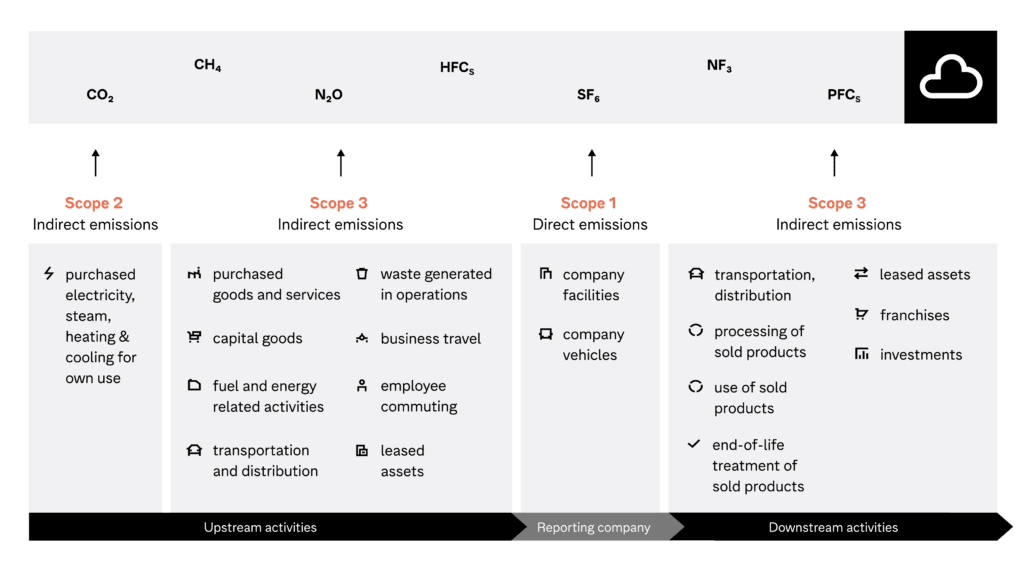Why your value chain’s carbon footprint matters

Over 90% of the average business's carbon footprint originates in the value chain.
Value chains are vital to reversing climate change
Though value chains often account for the biggest share of a company’s emissions, very few companies calculate their value chain carbon emissions.
For listed companies, it is not yet mandatory to disclose the greenhouse gas emissions generated in the value chain – though the CSRD may change that. In addition, calculating a full carbon footprint can take up to several weeks and requires very specific data, two things most companies don’t have.
Automation-assisted carbon accounting can calculate a full carbon footprint in a tenth of the time, using basic financial data. This includes the difficult-to-quantify value chain emissions.
Value chains are crucial for companies’ climate action. 1,000,000,000 tons of CO2 emissions could be avoided each year if suppliers to just 125 multinationals increased their renewable electricity by 20%. That’s the same amount of greenhouse gas emissions generated by Mexico and Brazil combined.
Companies have the power to shape the future of our planet. But why should they calculate value chain emissions and act upon them, if they are not required to do so?
Calculating your carbon footprint: scope 1, 2, and 3 emissions
Experts agree that reporting on value chain emissions will soon be mandatory – the only question is when.
Disclosing your value chain carbon footprint is not only a matter of compliance. It is a way to earn the trust of your stakeholders and identify risks in all of your business’s upstream and downstream activities.
The Greenhouse Gas (GHG) Protocol sets the standards to estimate GHG emissions all around the world, and virtually every corporate sustainability reporting program is based on it.
According to the GHG Protocol, corporate emissions are categorized into three groups: scope 1, scope 2, and scope 3:

Scope 1: direct emissions generated by owned or controlled resources. These are the emissions that a company generates while performing its business activities. In most cases, scope 1 emissions are generated by the fuel combustion that powers industrial processes or the vehicle fleet.
Scope 2: indirect emissions generated by the production of purchased electricity, steam, heating and cooling. These emissions are not generated by the company directly, but by the utilities that produce electricity, steam, heating and cooling.
Scope 3: all other indirect emissions that occur in a company’s value chain. Scope 3 emissions are generated by resources not owned or controlled by the company, but that the company indirectly impacts in its value chain.
Scope 3 emissions are also called value chain emissions, because they take into consideration the carbon footprint generated by a company’s suppliers.
Due to a tendency to specialize and outsource non-core activities, value chain emissions account for around 90% of companies’ carbon footprint. And this number may rise in the future.
Why calculate the carbon footprint of your value chain?
Calculating the carbon footprint of value chains should be a priority for businesses of any size.
Here are five reasons why every company should calculate its full carbon footprint:
1. Value chains hold the key to 90% of emission reductions
Scope 1 and 2 account for less than 10% of your carbon emissions, while over 90% are located far in the value chain. Look at IKEA, a bold climate leader committed to reducing GHG emissions across the full value chain (scope 1, 2, and 3). In the baseline year, IKEA’s scope 1 and 2 emissions were just 2% of total emissions, with the other 98% originating in the value chain. Had they calculated only scope 1 and 2 emissions, they wouldn’t have the information they needed to make an impactful reduction on their emissions – because incomplete calculations give incomplete results.
2. Disclosing value chain emissions earns trust & avoids greenwashing
Customers, investors, and employees increasingly demand that businesses share their climate impact. How would stakeholders react if your company’s financial report accounted for just 10 percent of its expenses? The same holds for your climate footprint. Companies that only calculate and disclose their scope 1 and 2 emissions neglect the majority of their climate impact – which, even if unintentional, could be percieved as greenwashing.
3. Reporting value chain emissions will soon be mandatory
It will not take long before regulators find the power to make it mandatory to report on your value chain emissions. The Sustainable Finance Disclosure Regulation (SFDR) required the disclosure of value chain emissions already in 2021, but due to COVID it has been postponed to 2023. The latest regulatory developments signal that companies will soon be required to disclose the climate footprint of their value chains. To stay ahead of the legislation, you should start calculate emissions now.
4. Value chains contain hidden business risks
Climate change will cause disruptions to global value chains, and the world’s leaders still don’t know what to do. With environmental issues taking center stage, the risk of adverse environmental regulations is higher than ever. Carbon prices already increased to €31 a tonne and are expected to reach €50 soon. By calculate your entire carbon footprint, you can uncover the emission hotspots of your value chain and reduce your CO2 emissions before the price gets too high.
5. Emission reduction means cost reduction
For many years, companies have seen sustainability as a burden to bear. Today, reducing greenhouse gas emissions is a great opportunity to gain efficiency and reduce costs. Two of the biggest sources of corporate emissions are materials and business travel. If you reduce the amount of materials used or the number of flights taken you are not only reducing emissions – you’re also cutting your costs.
How to start calculating your value chain carbon footprint
Value chains are the most powerful tool to curb carbon emissions. To reduce emissions, it’s vital to comprehensively calculate them – which in the case of value chains can prove tricky.
Because the emissions occur outside of a business’s walls, it can be hard to accurately quantify them. And for large businesses, whose suppliers can number in the thousands, it quickly becomes unfeasible to ask each and every supplier for emissions data.
That’s why the Greenhouse Gas Protocol (GHGP) recommends a hybrid approach to calculating emissions. This pragmatic approach involves using spend-based data to calculate an initial overview of a business’s emissions, then refining that overview with activity-based data beginning with the biggest sources of emissions.
Find more guidance on calculating and reducing value chain emissions in Normative’s guide: Enterprise Value Chain Carbon Emission Reduction.
Your entire carbon footprint – visualized & actionable
Normative’s emissions accounting engine shows you your company’s full climate footprint – including your supply chain – and highlights the highest-impact reduction actions you can take.











